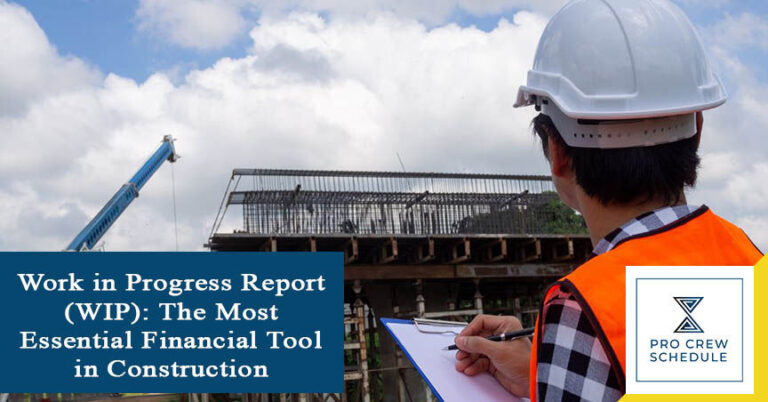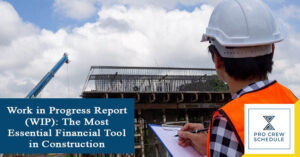As construction projects become more complex, project management becomes more complicated and extensive. Keeping your finances monitored is crucial for your business. You risk getting lost in the swirl of things if you don’t stay on top of your project. To help mitigate this, construction firms use the Work in Progress (WIP) Report technique to keep a close eye on their finances.
Construction accounting is a distinct branch of construction management. It is a complicated department in construction, as costs can pile up rapidly. Construction accountants monitor progress payments, assess construction liabilities, and compute construction costs. A construction WIP report can help companies better understand if they are over or underbilled.
What Is a Construction Work in Progress Report?
Construction WIP reports are documents construction accountants produce during each phase of a construction project. They are financial documents that help companies track their revenues and costs during a project’s lifecycle. WIP reports are necessary for any project that utilizes the Percentage of Completion (POC) accounting method. The main idea behind POC is that the percentage of completed work calculates expenses and revenue during a set timeline.
WIP reports may differ in format between construction companies. However, one thing common with them is the project-to-date and current period columns. Construction accountants use this to keep track of the progress and costs accrued during a specific period.
Accountants adopt WIP reporting to track a project’s progress and actualized costs to determine the exact amount left for further construction (or Cost to Complete). A construction WIP report helps accountants keep track of the company’s current expenses and revenue, giving them a clear outlook of their financial standing at any given point throughout the project’s lifecycle.
What Is a Construction WIP Report Important?
A typical construction project includes several departments, investors, lenders, subcontractors, trades, and suppliers. While each party has particular goals and expectations, project WIP reporting can be daunting. Nonetheless, it’s not just an additional feature you should consider in your operations. Construction companies risk exhausting their money without accurate reporting before the project is finished.
Since construction projects can last months or years, construction accountants must keep track of everything before the project’s turnover to see a clear outlook of their revenues and expenses. Construction companies are strictly advised to generate work-in-progress reports frequently and use the information to adjust remaining construction costs as needed.
What are the Consequences of Unorganized Financial Reporting?
Understanding your company’s financial state before the project is completed ensures that construction companies are not under or overbilled. Let’s examine the consequences of unorganized financial reporting.
Underbilling
With a construction WIP report, construction companies can avoid underbilling their customers, which leads to low money to complete the project.
Underbilling is the practice of charging less for labor and material schedules in construction. It can also affect subsequent construction projects, as companies won’t be able to afford them until completion. As a result, a company might endure financial losses and be unable to complete the construction phase promptly.
For example, if the first-phase construction company bills $100,000 while the actual costs turn out to be $150,000, it will lack $50,000 for the next construction stage. This can be covered up by an additional construction loan or the second-phase invoicing, increasing the total project costs.
Construction work-in-progress reports should become a fundamental part of construction management to guarantee that companies are not underbilling their customers.
Overbilling
Overbilling, as opposed to underbilling, refers to companies charging more than the real costs. Such practices may seem beneficial for companies, as they get extra funds once the construction project is turned over.
However, construction companies may face legal consequences if caught overbilling their projects. If a WIP report shows overbilling during the first construction phase, companies should make the necessary corrections before proceeding to the second phase.
In scenarios, construction companies may be able to return the difference and explain the honest mistake. However, a one-time overbilling can also be subtracted from the next-phase invoicing through proper documentation. In any case, returning the excess amount and keeping transparent construction cost records will help companies avoid serious legal consequences.
How to Build a Construction WIP Report?
As mentioned above, WIP accounting is essential to long-term and large-scale construction projects. Construction expenses must be tracked to avoid getting lost in bills and invoices when needed.
Making a construction WIP report requires extensive knowledge of construction accounting principles. An accountant should have general industry knowledge to understand the accounting basics and the construction process.
A typical WIP report has several breakdown estimations of the whole construction budget. One of the integral parts is the calculation of the Percent of Completion. This shows companies whether they are under or overbilled and allows them to apply the needed changes. Long-term contracts have estimates for revenues and costs. Use the below formula for calculations:
- Percent Complete = Actual Expense to Date / Total Estimated Expense
Accountants must consider the final number of the total estimated revenue and find the actual earned revenue to date.
- Actual Earned Revenue to Date = Total Estimated Revenue* Percent Complete
Construction accountants need these numbers when creating construction WIP reports. The difference between the company’s Total Expense on Contract and the Actual Earned Revenue to Date will reflect whether the project has Under/Over Billed Revenue.
- Total Expense on Contract – Actual Earned Revenue to Date = Under/ Over Billed Revenue
Construction companies should conduct financial audits of their expenses after every phase to avoid potential losses. Furthermore, longer projects require more detailed financial analysis with estimates and other statistics to ensure companies keep track of costs and make intelligent financial decisions.
Taking responsibility for precise expense tracking risks no miscommunication between companies and their customers. Still, it requires a laser-sharp focus and keen attention to detail.
What is the Project Manager’s Role in Construction WIP Reports?
WIP reports tend to be tools for construction accountants. They understand a project’s financials on a more professional and deeper level. They use WIP reports to ensure that companies stay within a pre-set construction crew scheduling and budgeting during the planning phase.
Nonetheless, neglecting the differences between what happens on the job site and what is written on the sheet is not an option. In other words, project managers and financiers should work together to make construction WIP reports as accurate and informative as possible.
So, while an accountant turns all numbers into a balanced status report, project managers should provide accurate cost-tracking info and estimate the cost to complete a project within the set timelines.
How to Improve the Accuracy of Construction WIP Reports?
Today’s connected, modern construction technologies and WIP strategies are helping project managers turn the tide. Here are two you can improve the accuracy of construction WIP reports.
Upgrade Construction Technology With Real-Time Data
Are you still utilizing spreadsheets to construct track projects? Unfortunately, spreadsheets are outdated and prone to errors due to manual data entry and declined accuracy from multiple editors handling the same sheet. People might enter different information in different places or fail to report a critical update, leading to budget pitfalls. One missing number can throw off the whole project’s financials.
However, the right connected construction employee scheduling software can keep you on track. This cloud-based platform utilizes a single source of information that is updated in real-time as updates occur. Construction accountants can streamline their WIP reporting and auto-update their reports with new information when billings are issued incorrectly. They can identify where potential problems may take place and take immediate action to avoid potential profit fade.
Collaborate and Connect with All Necessary Stakeholders
Though the construction accounting department typically handles WIP reporting, the strongest companies make WIP a team effort. Another benefit of using connected, modern construction employee scheduling software is that it brings all project stakeholders together in connected working spaces. That signifies getting regular data updates from the project manager, field teams, purchasing department, equipment managers, and more. The more accurate and updated data is shared in real-time, the more realistic WIP reports can be.
And it’s not just about pulling together all the project information in one area. Bring teams together regularly to learn and study from WIP data. Have frequent meetings that discuss what the financial data is showing and what can be done to collectively work to solve any project challenges identified in the previous data.
Key Takeaway
Team collaboration paired with construction crew scheduling software solutions is the key to a project’s success. When project managers, financiers, engineers, architects, and other professionals working on the construction project join their efforts with the help of Pro Crew Schedule, planning, execution, and the final results come out exactly as you imagine them.







